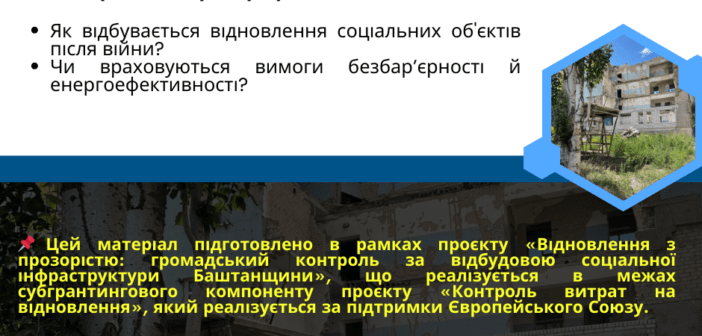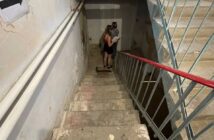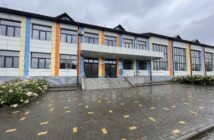 Після початку повномасштабної війни в Україні відновлення соціальної інфраструктури для доступу до різноманітних послуг стало одним із найважливіших завдань для місцевої влади, міжнародних організацій та волонтерів. Втім, необхідно враховувати те, що будівлі мають бути доступними для різних груп населення, зокрема маломобільних, відсоток яких значно підвищується. Лише за попередні два роки повномасштабного вторгнення кількість таких людей в Україні збільшилась на понад 300 тисяч осіб, в той час, коли раніше було лише зареєстрованих 3 млн. І це ще не поверталися військовослужбовці…
Після початку повномасштабної війни в Україні відновлення соціальної інфраструктури для доступу до різноманітних послуг стало одним із найважливіших завдань для місцевої влади, міжнародних організацій та волонтерів. Втім, необхідно враховувати те, що будівлі мають бути доступними для різних груп населення, зокрема маломобільних, відсоток яких значно підвищується. Лише за попередні два роки повномасштабного вторгнення кількість таких людей в Україні збільшилась на понад 300 тисяч осіб, в той час, коли раніше було лише зареєстрованих 3 млн. І це ще не поверталися військовослужбовці…
Йдеться про те, що відбудова та відновлення обʼєктів має відбуватися з такими підходами, як безбарʼєрність, енергоефективність, раціональність та прозорість. Хоч за тенденцію інклюзивного відновлення активно говорять, та чи насправді все так відбувається?
Ідеальна картина крізь призму проблем із доступністю
Часто бачимо, що в приміщеннях сучасний дизайн, яскраві фарби, зручні меблі, подекуди є навіть сучасна витяжка. Все це створює враження, що при виконанні робіт подбали про безпеку та комфорт людей. Однак наші експерти звернули увагу, що за цією ідеальною картиною приховується низка проблем.
Виявлено часткову реалізацію стандартів безбар’єрності, що потребує доопрацювання. Однією з найбільш кричущих проблем є доступність укриттів та будівель для маломобільних людей. Хоча облаштування деяких вбиралень з інклюзивним підходом є безсумнівно позитивним кроком, та самі вхідні двері та пороги залишають бажати кращого. Чому не було враховано всі аспекти доступності – питання відкрите. Така ж ситуація зі сходами.
Це приклад того, як зусилля можуть бути змарновані, якщо не враховуються потреби всіх користувачів приміщення. Зауважимо, що з 14 обʼєктів лише у 2 побачили повне врахування вимог безбарʼєрності, хоча в договорах йшлося про врахування ДБН, ДСТУ та іншим нормам НПА у сфері будівництва. Певно, що це було зумовлено тим, що ці 2 об’єкти, а саме нове будівництво ЦНАПів, відбувалося з «нуля». Надіємося, що при авторському нагляді ці порушення будуть виявлені та усунені.
Втім, крім цих проблем варто підкреслити й іншу: основні елементи енергоефективності, які враховують при відбудові, потребують подальшої оптимізації. Відбудова українських міст має бути на основі принципів і технологій енергоефективності та альтернативних джерел енергії. До прикладу, в Баштанській лікарні міжнародні партнери поставили сонячну електростанцію на 150 кВт, однак системи акумулювання енергії нема. Там, де немає станції, не завжди враховують випадки з відключенням електроенергії, однак будівлі намагаються термодернізувати (утеплювати) та встановлювати енергозберігаючі вікна.
Отже, підсумуємо. Відбудова чи відновлення – це не просто ремонт/облаштування приміщень чи будівництво, це турбота про людей, їхнє життя та безпеку. Важливо, щоб усі учасники цього процесу зрозуміли: громадськість стежить за кожним кроком і готова втрутитися, якщо виникають підозри щодо нечесності або неефективного використання коштів.
Невпинно боремося з системою, коли майже все відбувається не за наші гроші, а стандарти, на жаль, наші. На сайті організації та Великому Порталі Відновлення (BRP) презентуємо детальні результати моніторингу відбудови.
Цей матеріал підготовлено в рамках проєкту «Відновлення з прозорістю: громадський контроль за відбудовою соціальної інфраструктури Баштанщини», що реалізується в межах субгрантингового компоненту проєкту «Контроль витрат на відновлення», який реалізується за підтримки Європейського Союзу. Зміст цієї публікації є виключною відповідальністю «Проти Корупції» і жодним чином не відображає точку зору Європейського Союзу. Проєкт «Контроль витрат на відновлення» впроваджують Центр економічної стратегії, Інститут економічних досліджень та політичних консультацій та ГО «Технології прогресу».
New Ukraine, Old Barriers: How Is the Reconstruction Progressing?
Since the beginning of the full-scale war in Ukraine, the restoration of social infrastructure to ensure access to various services has become one of the most important tasks for local authorities, international organizations, and volunteers. However, it is necessary to take into account that buildings must be accessible to different groups of the population, including people with limited mobility, whose percentage has significantly increased. In just the first two years of the full-scale invasion, the number of such people in Ukraine increased by more than 300,000, while previously there were only 3 million registered. And this is before the return of servicemen…
The point is that the reconstruction and restoration of facilities should follow principles such as accessibility, energy efficiency, rationality, and transparency. While the trend toward inclusive recovery is actively discussed, is it really being implemented?
The ideal picture through the prism of accessibility issues
We often see that buildings have modern design, bright colors, comfortable furniture, and sometimes even modern ventilation systems. All this creates the impression that safety and comfort have been taken into account during the work. However, our experts have noted that behind this ideal picture lies a number of problems.
Partial implementation of accessibility standards was found, which needs further improvement. One of the most glaring issues is the accessibility of shelters and buildings for people with limited mobility. While the arrangement of some restrooms with an inclusive approach is undoubtedly a positive step, the entrance doors and thresholds themselves leave much to be desired. Why all aspects of accessibility were not considered remains an open question. The same situation applies to stairways.
This is an example of how efforts can be wasted if the needs of all users of the facility are not considered. It is worth noting that of the 14 facilities, only 2 fully complied with accessibility requirements, despite contracts stating compliance with SBC (State Building Codes), DSTU (State Standards of Ukraine), and other building standards and regulations. Apparently, this was due to the fact that these two facilities, namely the new construction of Centers for the Provision of Administrative Services (CPAS), were built from scratch. We hope that during the author’s supervision, these violations will be identified and corrected.
However, in addition to these problems, another issue should be emphasized: the main energy efficiency elements considered during reconstruction need further optimization. The rebuilding of Ukrainian cities should be based on energy efficiency principles and technologies, as well as alternative energy sources. For example, in the Bashtanka hospital, international partners installed a 150 kW solar power station, but there is no energy storage system. In places without such stations, cases of power outages are not always considered, although efforts are made to thermo-modernize buildings (insulate them) and install energy-efficient windows.
In conclusion, reconstruction or restoration is not just about repairs or construction; it’s about caring for people, their lives, and their safety. It is important for all participants in this process to understand that the public is watching every step and is ready to intervene if suspicions of dishonesty or inefficient use of funds arise.
We continue to fight the system where almost everything is done with funds not our own, but the standards, unfortunately, are ours. Detailed monitoring results of the reconstruction will be presented on the organization’s website and the Big Recovery Portal (BRP).
This material was prepared as part of the project «Recovery with Transparency: Public Control of the Reconstruction of Social Infrastructure in Bashtanka», implemented within the sub-granting component of the «Reconstruction Cost Control» project, which is supported by the European Union. The content of this publication is the sole responsibility of «Against Corruption» and in no way reflects the views of the European Union. The «Reconstruction Cost Control» project is implemented by the Center for Economic Strategy, the Institute for Economic Research and Policy Consulting, and the NGO «Technologies of Progress.»




